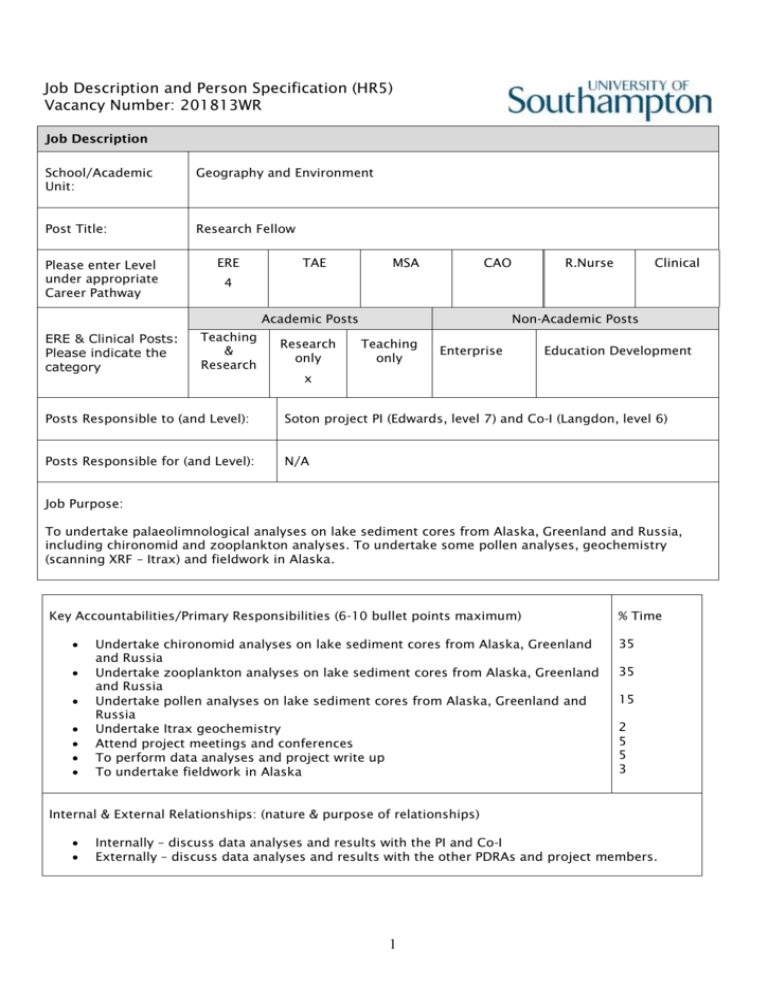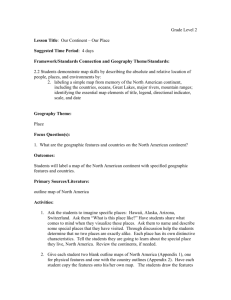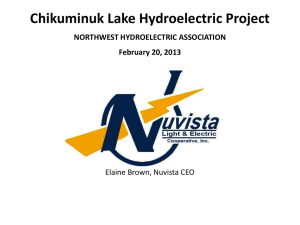Job Description and Person Specification
advertisement

Job Description and Person Specification (HR5) Vacancy Number: 201813WR Job Description School/Academic Unit: Geography and Environment Post Title: Research Fellow Please enter Level under appropriate Career Pathway ERE TAE MSA CAO Clinical 4 Academic Posts ERE & Clinical Posts: Please indicate the category R.Nurse Teaching & Research Research only Non-Academic Posts Teaching only Enterprise Education Development x Posts Responsible to (and Level): Soton project PI (Edwards, level 7) and Co-I (Langdon, level 6) Posts Responsible for (and Level): N/A Job Purpose: To undertake palaeolimnological analyses on lake sediment cores from Alaska, Greenland and Russia, including chironomid and zooplankton analyses. To undertake some pollen analyses, geochemistry (scanning XRF – Itrax) and fieldwork in Alaska. Key Accountabilities/Primary Responsibilities (6-10 bullet points maximum) Undertake chironomid analyses on lake sediment cores from Alaska, Greenland and Russia Undertake zooplankton analyses on lake sediment cores from Alaska, Greenland and Russia Undertake pollen analyses on lake sediment cores from Alaska, Greenland and Russia Undertake Itrax geochemistry Attend project meetings and conferences To perform data analyses and project write up To undertake fieldwork in Alaska % Time 35 35 15 2 5 5 3 Internal & External Relationships: (nature & purpose of relationships) Internally – discuss data analyses and results with the PI and Co-I Externally – discuss data analyses and results with the other PDRAs and project members. 1 Special Requirements: Ability to undertake fieldwork in Alaska in the summer. This will involve camping, hiking and carrying reasonable amounts of field kit. Person Specification Criteria Essential Desirable How to be assessed Qualifications, Knowledge and Experience: Expertise in chironomid analyses CV Experience of working with zooplankton and/or pollen (or willingness to learn) Experience of working with Pollen analyses Geochemistry expertise, Itrax or other methods Experience of working with geochemical data Experience of multivariate statistical analyses Experience of working with R/Matlab CV CV Degree in Geography, Earth Science or any Physical Science CV CV & interview PhD in Palaeoecology or a related aspect of Physical Geography/Earth Sciences/Environmental Science Knowledge of palaeolimnology and interest in Arctic Science, Carbon cycling and artic fieldwork Planning and Organising: Planning and undertaking fieldwork in challenging environments CV & interview Problem Solving and Initiative: fieldwork and data interpretation Statement and interview Management and Teamwork: Ability to work well in a team in Southampton, but also to link with other project members as necessary Ability to work both independently 2 Statement and Interview Communicating and Influencing: Ability to provide regular updates on progress and discuss the work with Soton and other project members Statement and Interview Other Skills and Behaviours: Good time management and ability to work to a deadline Special Requirements: (none) 3 Statement and interview Job Hazard Analysis Form - Appendix to Job and Person Specification Please tick one of the following statements: This post is an office-based job with routine office hazards e.g. use of VDU (if ticked, no further information needs to be supplied) This post has some hazards other than routine office e.g. more than use of VDU Please tick all those that apply, and put N/A if not applicable Environmental Exposures O* Outside work F C Extremes of temperature (eg fridge/ furnace) Potential for exposure to body fluids ## Noise (greater than 80 dba - 8 hrs twa) ## Exposure to hazardous substances (eg solvents, liquids, dust, fumes, biohazards). Specify …Laboratory preparations for pollen……………. ## Frequent hand washing Ionising radiation. Equipment/Tools/Machines used Food Handling ## Driving university vehicles(e.g. car/van/LGV/PCV) ## Use of latex gloves (note: prohibited unless specific clinical necessity) ## Vibrating tools ( e.g. strimmers, hammer drill, lawnmowers) ## Physical Abilities Load manual handling. Repetitive Crouching/Kneeling/Stooping Repetitive Pulling/Pushing Repetitive Lifting Standing for prolonged periods Repetitive Climbing i.e. steps, stools, ladders Fine motor grips (e.g. pipetting) Gross motor grips Repetitive reaching below shoulder height Repetitive reaching at shoulder height Repetitive reaching above shoulder height Psychosocial Issues Face to face contact with public Lone working Shift work/night work/on call duties ## 4 O – Occasionally (up to 1/3 of time); F – Frequently (up to 2/3 of time); C – Constantly (more than 2/3 of time) ## denotes to HR the need for a full PEHQ to be sent to all applicants for this position. FOR SCHOOL/SERVICE USE ONLY ResourceLink Post Number Which post does this job report to WR08001813 Is this post a Line Manager? Yes No x If yes, which posts directly report into it? ResourceLink Post Number Post 1 Post 2 Post 3 Post 4 Post 5 Post 6 Post 7 Post 8 Please add additional rows as required 5 Further Particulars Lakes and the Arctic carbon cycle Project background Lakes and the Arctic carbon cycle is a NERC funded research project led by Professor John Anderson (Loughborough), Professor Mary Edwards and Dr Peter Langdon (Southampton), with other collaborators from UCL and Nottingham. The Arctic is changing rapidly, and it is predicted that areas which are today tundra will become treecovered as warming progresses, with, for example, forest spreading northwards to the coast of northern European Russia by 2100. In some parts of the Arctic, such as Alaska, this process, commonly referred to as “greening”, has already been observed over the past few decades: woody shrubs are expanding their distribution northwards into tundra. Such vegetation changes influence nutrient cycling in soils, including carbon cycling, but the extent to which they will change the storage or release of carbon at a landscape scale is debated. Nor do we fully understand the role that lakes play in this system - but it is known that many lakes in the tundra and northern forests are today releasing carbon dioxide (and methane) into the atmosphere in significant amounts, and a proportion of this carbon comes into the lake from the vegetation and soils of the surrounding landscape. Lakes form an important part of arctic landscapes: there are many thousands of them in our study areas in Russia and west Greenland, for example, and they act as focal points for carbon cycling within in the larger landscape. It is vital that we understand the interactions between plants, soils, nutrients, and lakes because there are massive carbon stores in the high northern latitudes, (particularly in frozen soils), and if this carbon is transferred into the atmosphere (as carbon dioxide – CO2) it will create a positive feedback between regional warming and atmospheric CO2 concentration, driving further global warming. For this reason, the Arctic represents a critical component of the Earth System, and understanding how it will it respond to global environmental change is crucial. Lakes are a key link in this process. As lakes are tightly coupled with terrestrial carbon cycling, changes in the flows of carbon to a lake are faithfully recorded in lake sediment records, as are changes in the biological processing of that carbon within the lake. We also know that similar vegetation changes to those observed or predicted today occurred in the past when climate was warmer than today, and thus past events can provide an analogue for future changes. This project will examine lake sediment records, using techniques that extract a range of chemical signals and microscopic plant and animal remains, to see how vegetation changes associated with past natural climate warming, such as migration of the tree-line northwards, affected lake functioning in terms of the overall biological productivity, the species composition, and the types of carbon processing that were dominant. Depending upon the balance different biological processes, which in turn are linked to surrounding vegetation and soils, lakes may have contributed mostly to carbon storage or mostly to carbon emissions. Changes in vegetation type also influence decomposition of plant remains and soil development, and this is linked to nitrogen cycling and availability. Nitrogen is an important control over productivity and hence of carbon fixation and storage, and thus it is important to study the dynamics of nitrogen along with those of carbon. Due to the spatial variability of climate and geology, the pace of vegetation development (and of species immigration) and the types of plants involved have not been uniform around the Arctic. By examining several lakes in each of three regions (Alaska, Greenland, Russia) we will be able to describe a broad range of different vegetation transitions and the associated responses of the lakes. 6 Our results can be used to inform our understanding of the likely pathways of recently initiated and future changes. They can also be up-scaled to the whole Arctic and so contribute to the broader scientific goal of understanding feedbacks to global warming. 7









